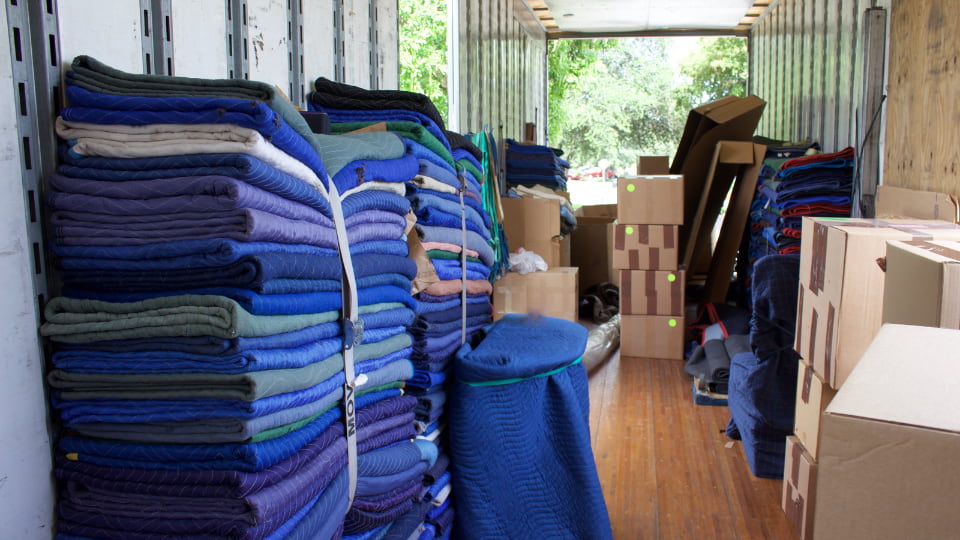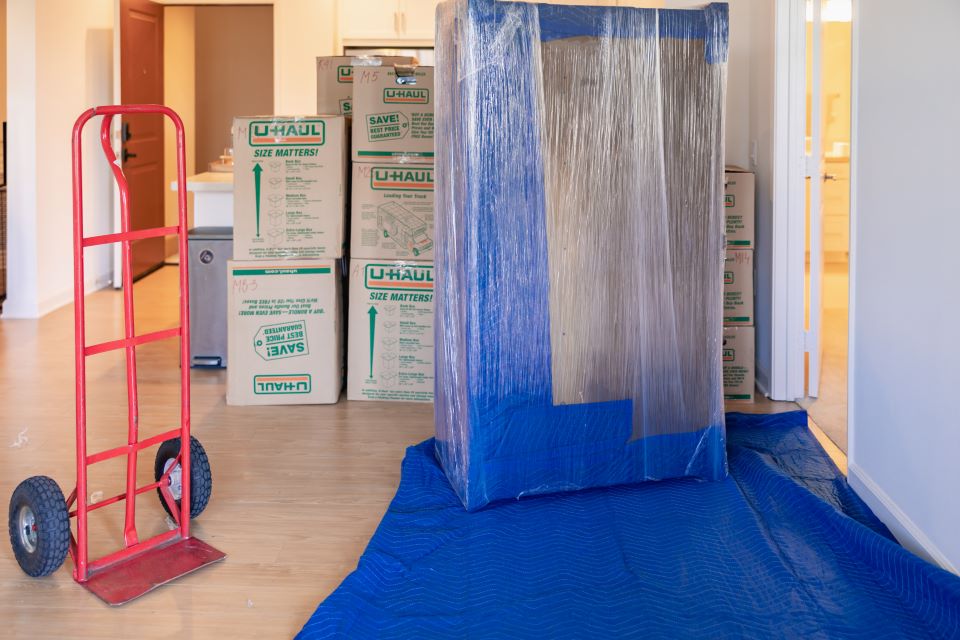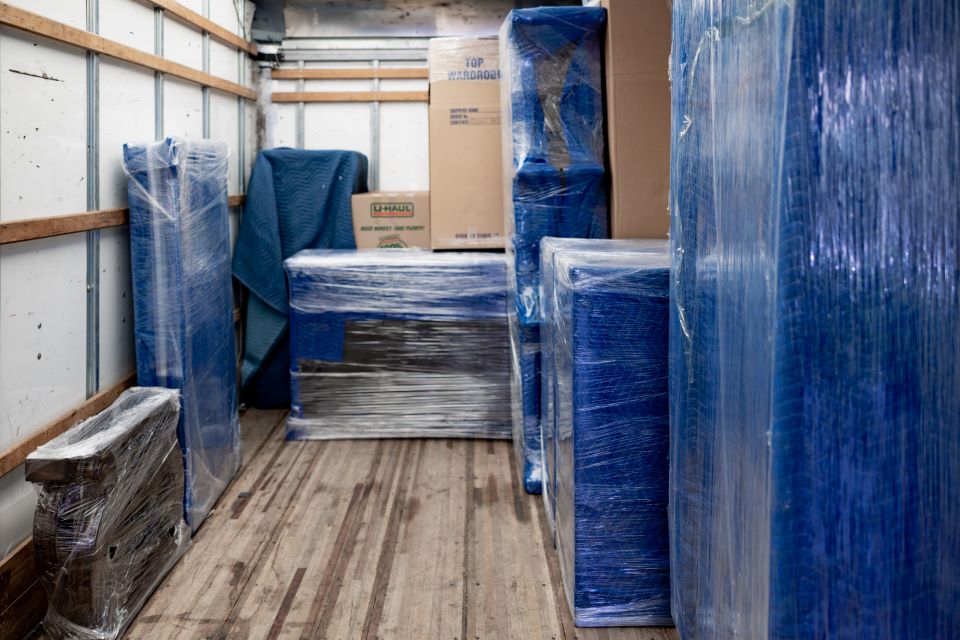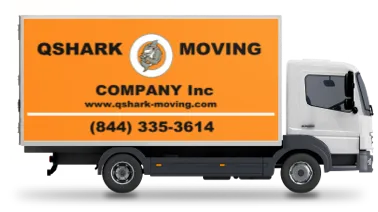How many Moving Blankets Do You Need?

Summary: This comprehensive guide explores the integral role moving blankets play in the relocation process, offering insights into how many you’ll need for a seamless move. Drawing on the expertise of QShark Moving Company, this article seeks to demystify the often overlooked yet essential aspect of moving. You’ll discover various factors determining the number of moving blankets required, practical examples for estimations, best practices when using them, and much more.
Short Answer:
| Property Size | Local Move (Short Distance) | Long-Distance Move |
|---|---|---|
| Small (Studio/1-Bedroom) | 12-15 Blankets | 20-25 Blankets |
| Medium (2-Bedroom) | 20-25 Blankets | 30-35 Blankets |
| Large (3-Bedroom and up) | 30-40 Blankets | 45-60 Blankets |
I. Introduction
Moving to a new home or office can be both exciting and stressful. Among the myriad details to consider, one aspect often overlooked is the role of moving blankets. These simple yet essential tools safeguard your valuable items, preventing damage and making a move smoother.
- What role does a moving blanket play?
Moving blankets, also known as moving pads, protect your furniture and other large items during the move. They help prevent scratches, dents, and other types of damage in transit.
- Why trust QShark Moving Company with this guide?
As professional movers, we at QShark Moving Company understand the ins and outs of moving, including the nuances of using moving blankets. Our vast experience as local movers has equipped us with the knowledge to provide you with the best advice and tips, ensuring a hassle-free moving experience.
This comprehensive guide delves into the nitty-gritty of moving blankets, helping you determine how many you’ll need for your next move. Let’s dive in!
In This Article:
| Sections | Key Points |
|---|---|
| What are Moving Blankets? | Padded coverings used to protect furniture and large items during a move. |
| Why are Moving Blankets Important? | They prevent damage to your belongings and reduce the risk of injury during the move. |
| Factors Determining the Number of Moving Blankets | Size of property, quantity and type of furniture, distance of move, fragility of items, specialty items, personal preference and budget. |
| Guide to Estimating Moving Blankets | Take inventory, assess each item’s coverage need, apply room estimate, factor in distance, and adjust based on personal preference. |
| Best Practices When Using Moving Blankets | Properly wrap items, ensure safety in transit, and reuse or recycle blankets after the move. |
| Professional Tips and Tricks from QShark’s Moving Experts | Maximize the utility of moving blankets, choose quality over quantity, consider renting vs. buying, and get help from professional movers. |
II. Understanding Moving Blankets
Before we dive into how many moving blankets you might need, it’s crucial to understand what they are and why they’re an essential part of the moving process.
A. What are Moving Blankets?
Moving blankets, often called moving or furniture pads, are protective coverings used during relocation. Made from durable materials, these blankets are a cushion for your items, protecting them from scratches, dents, or other damage during the move.
There are generally three types of moving blankets:
- Professional moving blankets: These are the highest quality and most durable. They are typically made from a mix of cotton and polyester and often have a woven structure for extra strength.
- Economy moving blankets: These are designed for limited usage, usually for a single move. They are typically made from non-woven polyester or a cotton and polyester mix.
- Paper moving pads: These are the most cost-effective option and are made from recycled paper. They are ideal for protecting items from dust and dirt but offer less protection against impacts.
B. Different Types of Moving Blankets and Their Uses
Each type of moving blanket is designed for specific use:
- Professional moving blankets: Ideal for professional movers, these provide maximum protection and are perfect for long-distance moves and fragile or valuable items.
- Economy moving blankets: Best suited for short-distance moves or less fragile items. They provide a basic level of protection and are usually more affordable.
- Paper moving pads: These are great for single-use scenarios, such as painting or renovation, in addition to moving. While they don’t offer as much protection, they’re an excellent choice for covering large areas or wrapping less fragile items.
- Weighted blankets: Primarily used for added stability and protection, weighted blankets are ideal for securing and cushioning heavier items during transit. They are heavier than standard moving blankets, providing enhanced shock absorption. This makes them particularly effective for protecting electronics, appliances, and other high-value items that may be sensitive to movement.
C. Why are Moving Blankets Essential for a Successful Move?
Moving blankets are pivotal to a successful, damage-free move. They:
- Protect your belongings from damage during transit
- Save you from potential repair or replacement costs
- Offer peace of mind, knowing your possessions are well-protected
- Can be used for various other purposes post-move, such as pet bedding, soundproofing, or during renovations.
Now that we’ve explored what moving blankets are and their importance, let’s examine the factors that influence how many you might need for your move.

III. Factors Determining the Number of Moving Blankets Needed
Determining the number of moving blankets needed for a move can be tricky. It depends on several factors, each contributing differently to the overall requirement.
A. Size of the Property
Naturally, the size of your home or office significantly affects the number of moving blankets you will need. Here’s a rough guide to help you estimate:
- One-bedroom property: Usually, 12 to 15 blankets suffice for a one-bedroom property.
- Two-bedroom property: Consider around 20 to 25 blankets for a two-bedroom property.
- Three-bedroom and larger properties may require 30 or more blankets, depending on the quantity and type of furniture.
Remember, these are just estimates, and the actual number may vary.
B. Quantity and Types of Furniture
The quantity and types of furniture you own can dramatically influence the number of moving blankets needed.
- Wooden furniture: Items like dining tables, chairs, desks, etc., often require full coverage to protect them from scratches and dents.
- Glass or delicate furniture may require extra padding, meaning more blankets, to ensure they remain intact during the move.
C. Distance of the Move
The further you’re moving, the more protection your items will need.
- Local moving: If you’re working with experienced local movers like QShark Moving Company, fewer blankets may suffice as the transit time is short.
- Long-distance moving: For long-distance moves, items are exposed to more prolonged movement, requiring extra protection. It’s advisable to use more moving blankets to ensure your belongings stay safe throughout the journey.
D. Fragility of Items
The fragility of your items is another important factor to consider.
- Robust items: Items like books, pots, and pans, and some sturdy appliances may not require a moving blanket at all.
- Fragile items: Delicate items like dishes, vases, electronic appliances, etc., often require additional padding. In this case, you might want to consider not just wrapping them in moving blankets, but also placing them in a box afterward for maximum protection.
E. Specialty Items
Specialty items like pianos, artwork, large appliances, etc., will require extra attention and likely more moving blankets.
- Artwork and Mirrors: Artwork and mirrors should be fully covered with moving blankets and then placed in a mirror/picture box.
- Appliances: Large appliances like refrigerators, washing machines, etc., should be fully wrapped with moving blankets to avoid scratches or dents.
- Pianos: Pianos are especially tricky due to their size and fragility. It’s recommended to use multiple blankets for full coverage.
F. Personal Preference and Budget
Ultimately, the number of moving blankets needed also depends on your preference and budget. You may want to invest in more blankets if you prefer maximum property protection. Conversely, you might use fewer blankets and take more risks if you’re on a tight budget.
Understanding these factors will provide a foundation for estimating the number of moving blankets required. Next, we’ll provide a step-by-step guide on making this estimation.

IV. A Comprehensive Guide to Estimating Moving Blankets
Estimating the number of moving blankets you need doesn’t have to be complicated. Follow this step-by-step guide to get a reasonable estimate.
A. Step-by-Step Guide on How to Estimate the Number of Moving Blankets Needed
1. Inventory Your Items:
The first step is to take a complete inventory of your belongings. Categorize items based on their type (wood, glass, appliances), fragility, and size.
2. Assess Each Item’s Coverage Need:
Determine how much coverage each item needs. Generally, more fragile and larger items will need more blankets.
3. Apply the Room Estimate:
Apply the basic room estimate guide provided in section III. A. Adjust as needed based on your inventory.
4. Factor in Distance:
Remember to consider the distance of the move. Longer moves usually require more padding for your items.
5. Adjust Based on Personal Preference:
Consider your comfort level. If you prefer extra protection, estimating on the higher end is okay.
B. Practical Examples Illustrating the Estimation Process
To help illustrate this, let’s walk through a couple of scenarios.
Scenario 1: A local move for a one-bedroom apartment with a mix of wooden and glass furniture, a large TV, and several pieces of artwork. We’d start with around 12-15 blankets based on the room estimate. However, considering the glass furniture and artwork, we might add an extra 5 blankets, bringing the total to around 17-20.
Scenario 2: A long-distance move for a three-bedroom house with many antique wooden furniture and a piano. Here, we’d start with the base estimate of 30 blankets for a three-bedroom house. Given the antique furniture, the piano, and the long-distance move, we’d add an extra 10-15 blankets. In this case, we’d estimate needing around 40-45 blankets.
Remember, these examples serve as a general guide and actual requirements may vary.
Using these steps and examples as a guide, you should get a reasonably accurate estimate of the number of moving blankets you’ll need. But having the right number of blankets is just the first step. Next, we’ll discuss best practices when using moving blankets.
V. Best Practices When Using Moving Blankets
Now that you know how many moving blankets you’ll need, it’s important to know how to use them effectively. Here are some best practices to keep in mind.
A. How to Properly Wrap Items with Moving Blankets
1. Fully Cover the Item:
Ensure the item is fully covered by the blanket. For furniture, start by placing the blanket over the top and allowing it to drape down the sides.
2. Secure the Blanket:
Secure the blanket with packing tape, making sure not to place the tape directly on the furniture to avoid leaving a sticky residue.
3. Double Up When Necessary:
For fragile or valuable items, consider using two blankets. Wrap the second blanket around the first for extra padding.
4. Keep Corners in Mind:
Pay extra attention to corners, which can easily get bumped during a move. Consider using additional padding at the corners.
B. Ensuring Safety and Preventing Damage While in Transit
1. Load Properly:
Load items wrapped in moving blankets carefully onto the truck. Heavier items should go on the bottom, while lighter ones should be on top.
2. Avoid Overloading:
Don’t overload the moving truck. Leaving some space allows for better weight distribution and prevents items from rubbing against each other.
3. Regularly Check the Load:
During long-distance moves, checking the load every few hours is wise to ensure the blankets haven’t shifted and items are still secure.
C. Tips on Reusing or Recycling Moving Blankets After the Move
1. Storage:
Use them as coverings for items in storage to keep dust away.
2. Pet Bedding:
They can be turned into bedding for pets.
3. Soundproofing:
Hang them up in a room you wish to soundproof.
4. Donate or Sell:
If you no longer need them, consider donating or selling them.
By following these best practices, you can ensure that your items are well-protected during the move and that your moving blankets serve you well even after the move. Next, we have exclusive tips and insights from our QShark’s moving professionals.

VI. Professional Tips and Tricks from QShark’s Moving Experts
In our years of service as professional movers, we at QShark Moving Company have gathered some exclusive tips and tricks to enhance your moving experience. Here are some pro insights straight from our experts.
A. Expert Recommendations for Maximizing the Utility of Moving Blankets
1. Think Beyond Furniture:
While moving blankets are commonly used for furniture, they can be used to protect all kinds of items, from appliances to valuable art pieces.
2. Utilize for Disassembling/Assembling Furniture:
Lay out a moving blanket when disassembling or assembling furniture. It can protect both the floor and the furniture parts from scratches.
3. Don’t Forget the Corners:
Reinforce corners of furniture with extra moving blankets, as these are areas prone to damage during transit.
B. Insider Tips on Choosing and Buying Moving Blankets
1. Quality Over Quantity:
A few high-quality moving blankets can offer better protection than many low-quality ones.
2. Rent vs. Buy:
Consider renting moving blankets if you’re on a tight budget or moving just once. But investing in your own set might be wiser if you foresee multiple moves or can use the blankets post-move.
C. How to Get Help from Professional Movers
1. Get Professional Assistance:
Our team at QShark is equipped to handle all your moving needs, including providing and utilizing moving blankets. Feel free to reach out to us for any assistance.
2. Request an In-House Estimate:
To get the most accurate estimate of how many moving blankets you’ll need (and a comprehensive quote for your move), consider requesting an in-house estimate.
Moving is more than just transporting items from point A to point B. It’s about ensuring the safe and efficient transportation of your belongings. As local movers with vast experience, we at QShark Moving Company hope this in-depth guide has been insightful and has equipped you with the knowledge you need to estimate and use moving blankets in your next move successfully. Happy moving!
VII. Conclusion
Knowing how many moving blankets you need is essential to planning a successful move. Not only do moving blankets protect your belongings during transit, but the right amount ensures that each item receives the protection it deserves. It all boils down to the size of your property, the type and quantity of items you own, the distance of the move, and your preference.
While it might seem daunting, the process becomes much simpler when you break it down step-by-step, as we have done in this article. From understanding what moving blankets are, the factors influencing their number, and how to use them properly, we’ve covered every detail you need to make an informed decision.
Always remember each move is unique. What worked for someone else might not work for you. Don’t hesitate to adjust the number of moving blankets as needed or seek professional movers’ help. QShark Moving Company is always ready to assist you and make your moving process as smooth as possible.
We hope this guide has been helpful in your moving journey. Here’s to a stress-free, damage-free move!
If you have more questions or need professional help, please get in touch with us. Our team of experienced movers at QShark Moving Company is always ready to assist you.


 Can You Wash Moving Blankets? Everything You Need To Know
Can You Wash Moving Blankets? Everything You Need To Know How to Use Moving Blankets: An In-Depth Guide by QShark Moving Company
How to Use Moving Blankets: An In-Depth Guide by QShark Moving Company